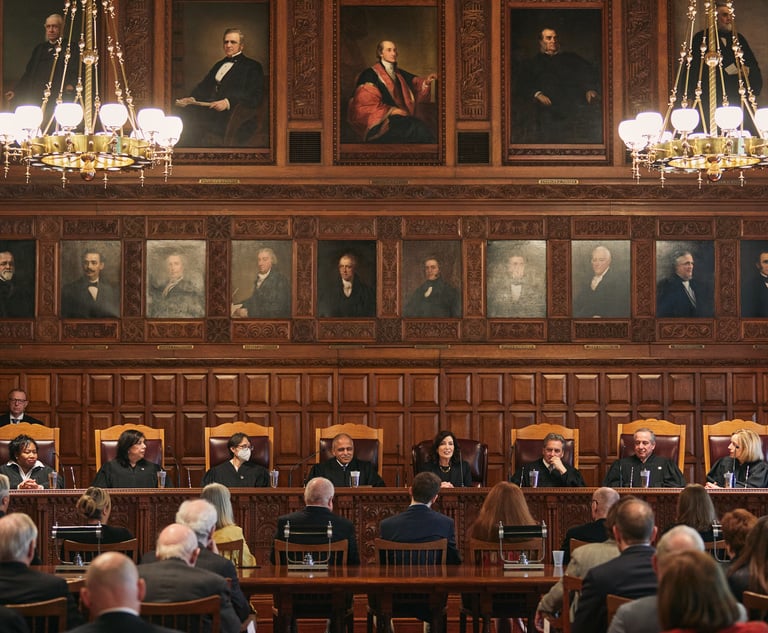Abandoning Treaties: Is the Outer Space Treaty Next?
Treaties are being abandoned or violated at an unprecedented rate. Not since the 1930s prelude to World War II have treaty obligations between and among nation-states so alarmingly unraveled. Is the 1967 Outer Space Treaty—the foundation of international space law—next to be dismantled?
October 17, 2019 at 12:00 PM
4 minute read
 Treaties are being abandoned or violated at an unprecedented rate. Not since the 1930s prelude to World War II have treaty obligations between and among nation-states so alarmingly unraveled.
Treaties are being abandoned or violated at an unprecedented rate. Not since the 1930s prelude to World War II have treaty obligations between and among nation-states so alarmingly unraveled.
Britain's Brexit speaks history.
Russia, four to five years ago, began violating the 1987 Intermediate-Range Nuclear Force Treaty by testing a new cruise missile, which it has now deployed. The United States has followed suit, testing a new missile and withdrawing from the Treaty.
China, a party to the 1994 Convention on the Law of the Sea, has violated its terms by building islands in the South China Sea, militarizing them and claiming the surrounding waters as territorial. Then China refused to abide by a UN tribunal that ruled in 2016 that it had no legal basis for such territorial claims.
The Philippines and several African countries have recently withdrawn or moved to withdraw from the International Criminal Court.
The United States on June 1, 2017 announced it would withdraw from the Paris Climate Treaty. (Pursuant to Treaty provision, Nov. 4, 2020 is the earliest official withdrawal date, which the U.S. has said it will formally respect.) In 2018, the U.S. withdrew from the Iran nuclear agreement negotiated by the five permanent members of the UN Security Council plus Germany and the European Union.
Is the 1967 Outer Space Treaty—the foundation of international space law—next to be dismantled? The Treaty's main provision, Article IV, prohibits: (1) placing, installing, or stationing in orbit around the earth or on any celestial body a nuclear weapon or any weapon of mass destruction (presumably chemical and biological weapons); (2) establishing a military base, installation or fortification on a celestial body; and (3) conducting any military maneuvers, including "testing of any type of weapons" on a celestial body.
The Treaty has 109 parties, including all declared nuclear weapon countries, the five UN Security Council permanent members, India, Pakistan, North Korea, plus Israel.
The Treaty is short, having nine preamble statements and 17 substantive articles, yet it stresses—by repeating seven times—that space is to be used for "peaceful purposes". As such, the spirit of the Treaty engenders an inclusive interpretation prohibiting all weapons, not just those of mass destruction, in outer space.
Here is the issue: On Aug. 29, 2019, President Trump officially reestablished the U.S. Space Command. (The Command was originally created in 1985 to coordinate the use of outer space by the U.S. military, but it became a low priority item when the 9/11 attack shifted focus to homeland security and counter-terrorism.) Its stated mission is to "deter aggression and conflict, defend U.S. and allied freedom of action, (and) deliver space combat power." Satellites of course are essential for both military and civilian communications, that is, for both security and the economy.
The president warned, "our adversaries are weaponizing Earth's orbits." In fact, the United States, Russia and China can each threaten the others' satellites and will increasingly be able to do so as each is making advances in new ground-to-ground and space-to-space weapons. (India has recently tested a ground-to-ground anti-satellite missile, making it the fourth country to do so.)
What to do? The United States and Russia have not had meaningful arms control discussions in more than six years. The United States, Russia and China have never had such discussions. Reaffirming the Outer Space Treaty making it clear that space is exclusively for peaceful pursuit is in everyone's interest. The United States should welcome ideological and economic competition with Russia and China. Unregulated weapons competition is, on the other hand, self-destructive.
David Lenefsky practices law in Manhattan. He was formerly Project Director for Arms Control at the United Nations Association-USA.
This content has been archived. It is available through our partners, LexisNexis® and Bloomberg Law.
To view this content, please continue to their sites.
Not a Lexis Subscriber?
Subscribe Now
Not a Bloomberg Law Subscriber?
Subscribe Now
NOT FOR REPRINT
© 2025 ALM Global, LLC, All Rights Reserved. Request academic re-use from www.copyright.com. All other uses, submit a request to [email protected]. For more information visit Asset & Logo Licensing.
You Might Like
View All
Jimmy Carter’s 1974 Law Day Speech: A Call for Lawyers to Do the Public Good
14 minute read
For Safer Traffic Stops, Replace Paper Documents With ‘Contactless’ Tech
4 minute readTrending Stories
- 1Six Judges Take Up New Leadership Roles in NYC Courts
- 2Carlos Ortiz Retiring After 35-Year Run as GC of Goya Foods
- 3'There's a Ticking Clock in This Case': Giuliani Held in Contempt in Defamation Enforcement Litigation
- 4Winter Storm Triggers US Court Closures in DC Metro Area and Midwest
- 5‘Not a Regulatory Gray Area’: CFTC Secures $5M Settlement From Gemini
Who Got The Work
Michael G. Bongiorno, Andrew Scott Dulberg and Elizabeth E. Driscoll from Wilmer Cutler Pickering Hale and Dorr have stepped in to represent Symbotic Inc., an A.I.-enabled technology platform that focuses on increasing supply chain efficiency, and other defendants in a pending shareholder derivative lawsuit. The case, filed Oct. 2 in Massachusetts District Court by the Brown Law Firm on behalf of Stephen Austen, accuses certain officers and directors of misleading investors in regard to Symbotic's potential for margin growth by failing to disclose that the company was not equipped to timely deploy its systems or manage expenses through project delays. The case, assigned to U.S. District Judge Nathaniel M. Gorton, is 1:24-cv-12522, Austen v. Cohen et al.
Who Got The Work
Edmund Polubinski and Marie Killmond of Davis Polk & Wardwell have entered appearances for data platform software development company MongoDB and other defendants in a pending shareholder derivative lawsuit. The action, filed Oct. 7 in New York Southern District Court by the Brown Law Firm, accuses the company's directors and/or officers of falsely expressing confidence in the company’s restructuring of its sales incentive plan and downplaying the severity of decreases in its upfront commitments. The case is 1:24-cv-07594, Roy v. Ittycheria et al.
Who Got The Work
Amy O. Bruchs and Kurt F. Ellison of Michael Best & Friedrich have entered appearances for Epic Systems Corp. in a pending employment discrimination lawsuit. The suit was filed Sept. 7 in Wisconsin Western District Court by Levine Eisberner LLC and Siri & Glimstad on behalf of a project manager who claims that he was wrongfully terminated after applying for a religious exemption to the defendant's COVID-19 vaccine mandate. The case, assigned to U.S. Magistrate Judge Anita Marie Boor, is 3:24-cv-00630, Secker, Nathan v. Epic Systems Corporation.
Who Got The Work
David X. Sullivan, Thomas J. Finn and Gregory A. Hall from McCarter & English have entered appearances for Sunrun Installation Services in a pending civil rights lawsuit. The complaint was filed Sept. 4 in Connecticut District Court by attorney Robert M. Berke on behalf of former employee George Edward Steins, who was arrested and charged with employing an unregistered home improvement salesperson. The complaint alleges that had Sunrun informed the Connecticut Department of Consumer Protection that the plaintiff's employment had ended in 2017 and that he no longer held Sunrun's home improvement contractor license, he would not have been hit with charges, which were dismissed in May 2024. The case, assigned to U.S. District Judge Jeffrey A. Meyer, is 3:24-cv-01423, Steins v. Sunrun, Inc. et al.
Who Got The Work
Greenberg Traurig shareholder Joshua L. Raskin has entered an appearance for boohoo.com UK Ltd. in a pending patent infringement lawsuit. The suit, filed Sept. 3 in Texas Eastern District Court by Rozier Hardt McDonough on behalf of Alto Dynamics, asserts five patents related to an online shopping platform. The case, assigned to U.S. District Judge Rodney Gilstrap, is 2:24-cv-00719, Alto Dynamics, LLC v. boohoo.com UK Limited.
Featured Firms
Law Offices of Gary Martin Hays & Associates, P.C.
(470) 294-1674
Law Offices of Mark E. Salomone
(857) 444-6468
Smith & Hassler
(713) 739-1250








